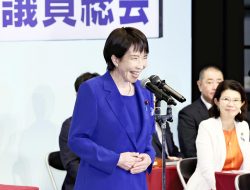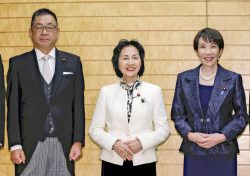Revisiting Crichton’s ‘Rising Sun’ Shows A Changed World; Once Rivals, Japan and U.S. Now Face China Together

Los Angeles Dodgers star Shohei Ohtani has become a new symbol of the Japan-U.S. relationship.
8:00 JST, November 9, 2024
Prime Minister Shigeru Ishiba inaugurated his Cabinet last month, and U.S. President-elect Donald Trump will be inaugurated in January next year.
Japan and the U.S. became allies after World War II, yet they also engaged in trade friction, which could be called war in the economic field, in the 1980s. Today, the U.S. economy is showing overwhelming strength, while Japan’s stagnation is remarkable. How will the new Japanese and U.S. administrations build a cooperative economic relationship going forward?
Michael Crichton, best known as the author of “Jurassic Park,” a story about dinosaurs resurrected by biotechnology, also published a mystery novel called “Rising Sun” in 1992, based on Japan-U.S. economic friction.
In the novel, a Japanese company called Nakamoto is holding a party to celebrate the completion of a skyscraper in Los Angeles when the body of a white female model is found inside the building. The story follows an American detective, who is an expert on Japan, as he closes in on the culprit and includes explanations of Japanese culture at various points.
The book opens with a Japanese motto, “Business is war,” and concludes with the symbolic words of Akio Morita, a cofounder of Sony: “If you don’t want Japan to buy it, don’t sell it.”
After World War II, the Japanese economy grew to the extent that it was seen as a threat to the United States. Reflecting Americans’ feelings toward Japan at the time, the book contains frequent instances of discriminatory expressions toward the Japanese. When a film based on the novel was released, Asian groups expressed concern, saying that the movie portrayed all Japanese people as being blackhearted and lacking in emotion.
When you read this mystery novel now, what catches your eye are the many episodes that show the overwhelming strength of the Japanese economy.
Consider this passage: “We’ve lost too many basic industries to Japan — steel and shipbuilding in the sixties, television and computer chips in the seventies, machine tools in the eighties. One day somebody wakes up and realizes these industries are vital for American defense. We’ve lost the ability to make components essential to our national security. We’re entirely dependent on Japan to supply them.”
Referring to a certain sophisticated image-recognition software, one character laments: “Oh, it’s not for sale here. The most advanced Japanese video equipment isn’t available in this country. They keep us three to five years behind.”
In the afterword, Crichton wrote: “Sooner or later, the United States must come to grips with the fact that Japan has become the leading industrial nation in the world. The Japanese have the longest lifespan. They have the highest employment, the highest literacy, the smallest gap between rich and poor. Their manufactured products have the highest quality. They have the best food. The fact is that a country the size of Montana, with half our population, will soon have an economy equal to ours.”
The author also sounded a warning to the United States itself. “The Japanese are not our saviors. They are our competitors. We should not forget that.”
However, Crichton’s prediction was wrong.
In 1995, Japan accounted for about 18% of the world’s gross domestic product. Japan’s GDP was about 70% the size of the U.S. GDP, and its per capita GDP was about 50% higher.
But in 2024, the United States is estimated to account for around 27% of the world’s GDP, while Japan’s share is around 4%. Japan has fallen from second place to fourth.
In 1989, eight Japanese companies appeared in the top 10 places in the world market capitalization rankings, with NTT first followed by Japanese banks. The highest-ranking U.S. company was IBM, in sixth place.
Now, that same top 10 list is dominated by U.S. companies, including Microsoft, Apple, Nvidia and Alphabet (Google’s parent company). No Japanese companies appear.
There are many reasons for “the lost three decades” of the Japanese economy. One of the main reasons is that the strengths of the Japanese economy at the time turned into weaknesses.
The strength of Japan’s manufacturing industry was its diligent workforce and the close collaboration among those in manufacturing, design and technology, which resulted in high-quality products with few faults.
However, as digitization progressed, the source of added value shifted from tangible to intangible assets, and Japanese manufacturing companies lost their strength. In the winner-take-all digital era, innovation and dynamism came to determine the winners and losers in business.
On that point, here’s another passage from the novel: “They kaizen ’em. A process of deliberate, patient, continual refinements. Each year the products get a little better, a little smaller, a little cheaper. Americans don’t think that way. Americans are always looking for the quantum leap, the big advance forward. Americans try to hit a home run — to knock it out of the park — and then sit back. The Japanese just hit singles all day long, and never sit back.”
At the time Crichton wrote it, this passage did explain why the Japanese economy continued to win, and the American economy continued to decline.
But now, it is different. The baseball analogy now shows why the United States has recovered to the point of boasting overwhelming strength, and Japan has fallen behind.
The Japanese economy is now shifting from rivalry with the United States to cooperation, as both countries aim to counter a rising China.
It is changing into a new economic alliance. IBM’s full technical cooperation with Rapidus, a semiconductor firm led by the Japanese government that aims at domestic production of advanced semiconductors, symbolizes this.
Nippon Steel Corp.’s planned acquisition of United States Steel Corp. provoked a reaction reminiscent of the trade friction in the 1980s and became a political issue — but that’s not what the pending deal is about. The essence of the matter is that a Japan-U.S. steel alliance could counter the Chinese steel industry, which continues to overproduce.
In the novel, a Japanese businessman struts around Los Angeles as if he owns the place.
Today’s real-life scene is different. One Japanese man, Shohei Ohtani, is hitting home run after home run on a Los Angeles baseball field as a new symbol of the Japan-U.S. relationship.
The relationship between Japan and the United States has experienced many significant changes over time.
After the new Trump administration starts, it will be necessary for the Japanese government to rethink its strategy for building relations.
It has been pointed out that Trump appears to hold views on Japan from the 1980s, when trade friction between Japan and the United States was intense.
Trump may impose tariffs on imports from other countries, including Japan, to protect domestic industries and promote the “America First” policy, which could negatively impact the Japanese economy. Trump has publicly stated that he will prevent Nippon Steel from acquiring U.S. Steel.
There may be more difficult times ahead.
The relationship between Japan and the United States has overcome many rough patches and strengthened over time; this alliance, having gone through such experiences, will be able to find a good path forward. That is the hope.
Political Pulse appears every Saturday.

Akihiro Okada
Akihiro Okada is a vice chairman of the editorial board for The Yomiuri Shimbun.
"Editorial & Columns" POPULAR ARTICLE
-

Violations of Subcontract Law: Major Automakers Must Eliminate Old Practices
-

Local Governments’ Tax Revenues: Devise Ways to Correct Imbalances in Tax Sources
-

5 Japanese Business Dinner Mistakes to Avoid — and What They Taught Me About Business in Japan
-

Heavy Rains in Asia: Support for Victims, Flood-Control Measures Urgently Needed
-

Rice Coupons: A Misguided Approach to Countering Rising Prices
JN ACCESS RANKING
-

Tokyo Economic Security Forum to Hold Inaugural Meeting Amid Tense Global Environment
-

Keidanren Chairman Yoshinobu Tsutsui Visits Kashiwazaki-Kariwa Nuclear Power Plant; Inspects New Emergency Safety System
-

Imports of Rare Earths from China Facing Delays, May Be Caused by Deterioration of Japan-China Relations
-

University of Tokyo Professor Discusses Japanese Economic Security in Interview Ahead of Forum
-

Japan Pulls out of Vietnam Nuclear Project, Complicating Hanoi’s Power Plans


























